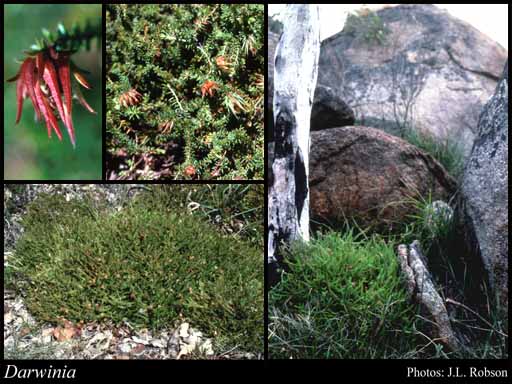- Reference
- Trans.Linn.Soc.London,Bot. p299, t. 22. (1816)
- Name Status
- Current







Scientific Description
Common name. Bells. Family Myrtaceae.
Includes D. verticordina (F. Muell.) Benth. (N.G. Marchant pers. comm.).
Habit and leaf form. Shrubs; evergreen; bearing essential oils. Plants with neither basal nor terminal concentrations of leaves; to 0.2–3 m high. Leptocaul. Helophytic to xerophytic. Leaves minute to medium-sized; alternate, or opposite; decussate; ‘herbaceous’, or leathery; petiolate to subsessile; gland-dotted; aromatic; edgewise to the stem, or with ‘normal’ orientation; simple; epulvinate. Leaf blades dorsiventral, or isobilateral, or centric; entire; flat, or solid; terete, or solid/angular (triquetrous); linear, or lanceolate, or oblong, or ovate; linear, or ovate, or obovate; pinnately veined, or parallel-veined, or one-veined; cross-venulate, or without cross-venules. Mature leaf blades adaxially glabrous; abaxially glabrous. Leaves without stipules; without a persistent basal meristem. Leaf anatomy. Hairs absent. Stem anatomy. Secondary thickening developing from a conventional cambial ring.
Reproductive type, pollination. Fertile flowers hermaphrodite. Unisexual flowers absent. Plants hermaphrodite. Entomophilous, or ornithophilous (or autogamous, in D. pimelioides). Pollination mechanism conspicuously specialized, or unspecialized.
Inflorescence and flower features. Flowers aggregated in ‘inflorescences’; in racemes, or in heads. The terminal inflorescence unit cymose. Inflorescences terminal; usually condensed; with involucral bracts, or without involucral bracts (as in D. pauciflora); pseudanthial, or not pseudanthial. Flowers pedicellate to sessile; bracteate; ebracteolate, or bracteolate (bracteoles 2 or 4). Bracteoles persistent, or deciduous. Flowers small to medium-sized; regular; 5 merous; cyclic. Free hypanthium present (petals ‘inserted on the calyx’); campanulate to tubular; extending beyond ovary; often distinctly 5-ribbed or rugose in the basal part. Hypogynous disk present. Perianth with distinct calyx and corolla; 10; 2 -whorled; isomerous. Calyx present; 5; 1 -whorled; gamosepalous. Calyx segments entire (or irregularly dentate-ciliate in D. verticordina). Calyx imbricate, or valvate; exceeded by the corolla (often minute), or more or less equalling the corolla; regular; persistent. Calyx lobes elliptic, or oblong, or ovate, or triangular. Corolla present; 5; 1 -whorled; polypetalous; imbricate; regular; green, or white, or cream, or yellow, or red, or purple; persistent. Petals elliptic, or oblong, or ovate. Corolla members entire. Androecial members definite in number. Androecium 20. Androecial members branched. Androecial sequence determinable, or not determinable. Androecial members free of the perianth, or adnate (to the petals); markedly unequal; coherent; 1 - adelphous (connate into a tube); 1 -whorled. Androecium including staminodes. Staminodes 10 (alternating with the stamens); petaloid, or non-petaloid (filamentous). Stamens 10; attached on the rim of the hypanthium, or attached above the hypanthium (when adnate to petals); remaining included (shorter than the petals); all more or less similar in shape; diplostemonous; alternisepalous and oppositisepalous; both opposite and alternating with the corolla members; erect in bud, or inflexed in bud. Filaments not geniculate; filiform. Anthers all alike; dorsifixed; versatile, or non-versatile; dehiscing via pores (pores terminal); introrse; tetrasporangiate. Gynoecium 2 carpelled. The pistil 1 celled. Gynoecium syncarpous; eu-syncarpous; inferior, or partly inferior. Ovary unilocular; 1 locular. Epigynous disk present, or absent. Gynoecium stylate. Styles 1; simple; apical; becoming exserted; hairy (towards the summit). Stigmas 1. Placentation axile- basal. Ovules in the single cavity 2–4(–6); on a stalked placenta; collateral (or in collateral pairs); non-arillate; anatropous.
Fruit and seed features. Fruit non-fleshy; indehiscent; a nut; 1 celled; usually 1 seeded. Seeds non-endospermic. Cotyledons 2.
Geography, cytology, number of species. Native of Australia. Endemic to Australia. Australian states and territories: Western Australia, South Australia, Queensland, New South Wales, and Victoria. South-West Botanical Province. N=6.
Etymology. After Erasmus Darwin (1731–1802), English physician and poet, grandfather of Charles Darwin.
Keys
A Key to Western Australian Species in the Chamelaucieae Tribe of Myrtaceae
B.L. Rye, M.D. Barrett, T.D. Macfarlane, N.S. Lander, M.E. Trudgen, N.G. Marchant, K.R. Thiele
Taxonomic Literature
- Keighery, G. J.; Marchant, Neville 2002. A new species of Darwinia (Myrtaceae) from Western Australia.
- Wheeler, Judy; Marchant, Neville; Lewington, Margaret; Graham, Lorraine 2002. Flora of the south west, Bunbury, Augusta, Denmark. Volume 2, dicotyledons. Australian Biological Resources Study.. Canberra..
- Marchant, N. G.; Wheeler, J. R.; Rye, B. L.; Bennett, E. M.; Lander, N. S.; Macfarlane, T. D.; Western Australian Herbarium 1987. Flora of the Perth region. Part one. Western Australian Herbarium.. [Perth]..
- Marchant, N. G. 1984. A new species of Darwinia (Myrtaceae) from the Perth region, Western Australia.
- Blake, Trevor L. 1981. A guide to Darwinia and Homoranthus. Society for Growing Australian Plants, Maroondah Group.. Ringwood, Vic..
- Blackall, William E.; Grieve, Brian J. 1980. How to know Western Australian wildflowers : a key to the flora of the extratropical regions of Western Australia. Part IIIA. University of W.A. Press.. [Perth]..
- Marchant, N. G.; Keighery, G. J. 1980. A new species and a new combination in Darwinia (Myrtaceae) from Western Australia.